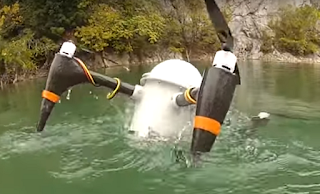Hybrid Drones - the Advantages of Operating in Multiple Domains
Classifying unmanned maritime systems by their operating domain: air, surface, or underwater - is both convenient and intuitive. But recently, navy and industry researchers have begun to explore the advantages of platforms that can operate in two domains, muddying the nomenclature. In the past year, several prototype multi-domain unmanned vehicles have been introduced.
The most popular combination of these hybrid drones is the air/sub-surface mixture - UAVs that float or swim. Johns Hopkins University Applied Physics Laboratory in Laurel, Maryland introduced the Corrosion Resistant Aerial Covert Unmanned Nautical System (CRACUNS), a submersible UAV designed to operate in the littorals which can be launched from a fixed position underwater or from an unmanned underwater vehicle (UUV).
Rutger University's entry into the fray of flying/swimming drones is the Naviator, which can actually maneuver (sort of) underwater before surfacing and taking off.
Naval Postgraduate School students built the Aqua-Quad, a small quadcopter with the ability to land and drift on the ocean's surface. Singapore's ST Engineering has produced the Unmanned Hybrid Vehicle (UHV), which can fly for short ranges then move at 4-5 knots underwater. Perhaps the most advanced air/sub-surface combo vehicle is the Naval Research Laboratory's FLIMMER.
Another take on the multi-domain hybrid is American Unmanned Systems spherical Guardbot, an amphibious surveillance robot that can cross from the sea to land.
Currently, these vehicles are all prototypes in the testing stage. It's not clear, which, if any, will see practical application in maritime operations. What sort of tactical advantage might these vehicles bring to naval missions? The ability to launch a fairly short-ranged UAV from a ship or a larger aircraft to rapidly and precisely deploy an unattended sensor in the water column could be important for anti-submarine warfare. For instance, deploying a hydrophone with acoustic sensors can be done directly - like when a maritime patrol aircraft dispenses a disposable sonobuoy. But a hybrid UAV could deploy, listen, then move and listen in another place, using the same vehicle, and potentially recover to a mothership. The same situation could also be used to deploy hydrographic monitoring instruments, important for ASW, but also mine warfare.
Ocean Aero, a company out of San Diego, California, is developing a combined surface/subsurface vehicle, the Submaran S10. The vehicle runs from a combination of sail and solar power, giving it extremely long endurance for intelligence, surveillance, and reconnaissance (ISR) missions. In this case, submerging could help the vehicle to avoid detection from surface and air platforms.
Of course this versatility results in trade-offs. None of these platforms will excel performance-wise in either operating domain. The vehicles listed above have fairly short ranges compared to single purpose platforms. Flight ranges may be short, but in ASW and other applications, there is an advantage to being able to drift on or under the water and listen while consuming very little power. The Aqua-Quad is designed to do just that, with the help of photo-voltaic cells.
Though these smaller vehicles have limited range compared to say a MALE UAV, they will also be much less expensive than long-endurance vehicles, meaning they can be acquired and deployed in quantity. Operating in swarms, hybrid vehicles can become a force multiplier, distributing many sensors -- and possibly weapons -- over wider ranges. There are certainly situations in which the ability to move between the air, and on or under the water make sense.
 |
| CRACUNS |
Naval Postgraduate School students built the Aqua-Quad, a small quadcopter with the ability to land and drift on the ocean's surface. Singapore's ST Engineering has produced the Unmanned Hybrid Vehicle (UHV), which can fly for short ranges then move at 4-5 knots underwater. Perhaps the most advanced air/sub-surface combo vehicle is the Naval Research Laboratory's FLIMMER.
Another take on the multi-domain hybrid is American Unmanned Systems spherical Guardbot, an amphibious surveillance robot that can cross from the sea to land.
 |
| Unmanned Hybrid Vehicle (image courtesy of Shepherd Media) |
Ocean Aero, a company out of San Diego, California, is developing a combined surface/subsurface vehicle, the Submaran S10. The vehicle runs from a combination of sail and solar power, giving it extremely long endurance for intelligence, surveillance, and reconnaissance (ISR) missions. In this case, submerging could help the vehicle to avoid detection from surface and air platforms.
Of course this versatility results in trade-offs. None of these platforms will excel performance-wise in either operating domain. The vehicles listed above have fairly short ranges compared to single purpose platforms. Flight ranges may be short, but in ASW and other applications, there is an advantage to being able to drift on or under the water and listen while consuming very little power. The Aqua-Quad is designed to do just that, with the help of photo-voltaic cells.
Though these smaller vehicles have limited range compared to say a MALE UAV, they will also be much less expensive than long-endurance vehicles, meaning they can be acquired and deployed in quantity. Operating in swarms, hybrid vehicles can become a force multiplier, distributing many sensors -- and possibly weapons -- over wider ranges. There are certainly situations in which the ability to move between the air, and on or under the water make sense.

Comments
Post a Comment